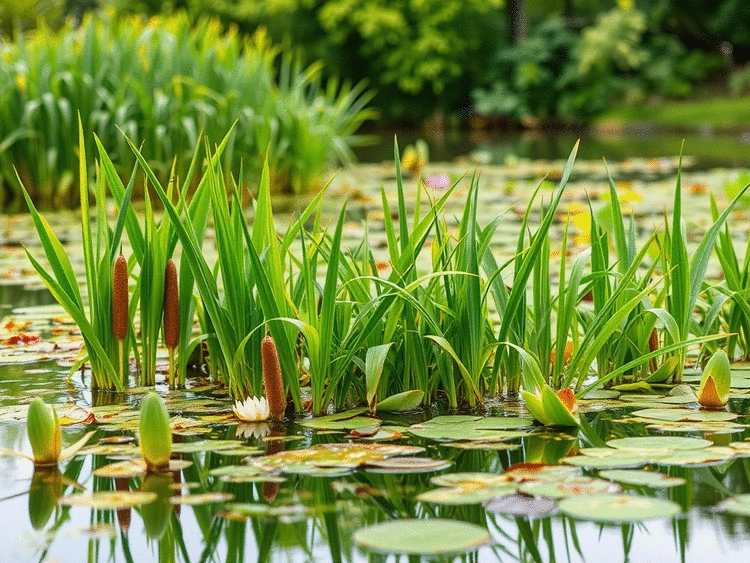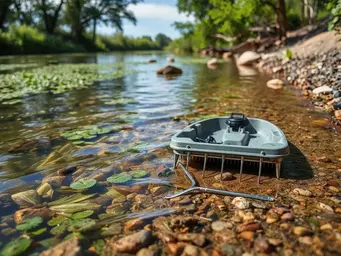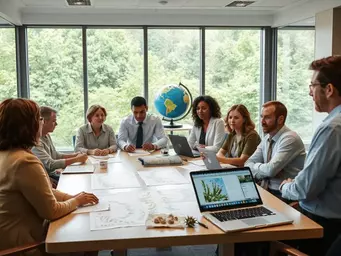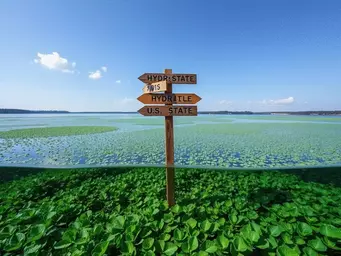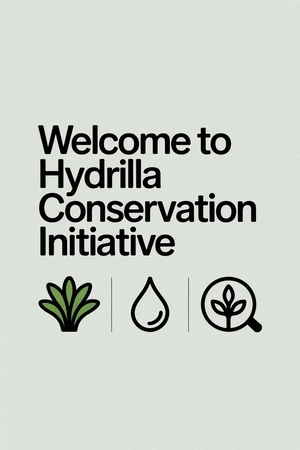As you navigate through the complexities of our waterways, consider the unseen challenges that invasive species like hydrilla pose. What if your awareness could spark a movement for change? Understanding hydrilla is not just for scientists; it's a call to action for all who cherish our aquatic environments.
What You Will Learn
- Hydrilla can grow up to a foot per week, rapidly dominating aquatic environments.
- This invasive plant reproduces through seeds, tubers, and fragmentation, complicating control efforts.
- Understanding its life cycle and adaptability is crucial for effective management strategies.
- Community education and involvement are essential in preventing hydrilla's spread and restoring native ecosystems.
- Effective management requires collaboration among local governments, recreational users, and community groups.
- Engaging in aquatic plant surveys can help in the early detection of hydrilla and other invasive species.
Hydrilla's Invasive Lifecycle & Impact
This visual illustrates the key methods by which Hydrilla reproduces and spreads, along with its rapid growth rate and the resulting ecological consequences.
Hydrilla's Reproductive Versatility
Hydrilla utilizes multiple strategies to ensure its rapid spread and survival, making control challenging.
Key Impacts on Ecosystem Health
The aggressive growth of Hydrilla leads to significant ecological imbalances and degradation.
Understanding Hydrilla: An Invasive Aquatic Plant
As an aquatic biologist, I've spent years exploring the complexities of hydrilla verticillata, an invasive aquatic plant that poses a significant threat to our waterways. This seemingly innocent plant is often mistaken for a native species due to its lush green appearance. However, it’s crucial to understand why hydrilla is a concern for both ecosystems and local communities. It can rapidly outgrow and overpower native plants, leading to severe ecological imbalances. Have you ever noticed how the presence of one species can shift the entire landscape of an ecosystem?
Hydrilla's ability to thrive in various water conditions makes it particularly problematic. It can grow in still or slow-moving waters, and its adaptability allows it to spread quickly. This rapid growth not only leads to dense mats on the water's surface but also disrupts the delicate balance of aquatic ecosystems. In areas where hydrilla has taken hold, the native flora and fauna often struggle to survive, raising alarms for conservationists like myself! For further information on managing invasive species in federal projects, you can refer to resources from the U.S. Army Corps of Engineers.
What is Hydrilla verticillata and Why is it a Concern?
To truly appreciate the impact of hydrilla, we need to delve into its biology. Hydrilla is a perennial plant that can reproduce through various means, including seeds, tubers, and fragmentation. Each of these methods contributes to its invasive nature, allowing it to spread swiftly throughout water bodies. For instance, even a small fragment can give rise to a new plant! This agility in reproduction makes it a formidable adversary against native species.
- Rapid Growth: Hydrilla can grow up to a foot per week under optimal conditions.
- Reproductive Versatility: It can reproduce through seeds, tubers, or fragmentation, making it difficult to control.
- Adaptability: It thrives in diverse water conditions, from ponds to lakes.
From a management perspective, understanding these traits is essential for developing effective strategies to combat its spread. The sooner we recognize hydrilla’s presence, the better chance we have to mitigate its impact on our ecosystems. Details on management plans for specific water bodies, such as Raystown Lake, can be found on the U.S. Army Corps of Engineers website.
The Life Cycle of Hydrilla: Tubers, Turions, and Fragmentation
Hydrilla's life cycle is a fascinating yet alarming aspect of its biology. One of the most critical elements is the formation of tubers—small, potato-like structures that can remain dormant in the sediment for long periods. When conditions are right, these tubers can sprout into new plants, effectively ensuring the species' survival even in challenging environments. Have you ever spotted a single hydrilla plant in a waterway? That could be just the tip of the iceberg!
- Tubers: Underground storage organs that allow hydrilla to survive harsh conditions.
- Turions: Bud-like structures that float on the water surface, capable of developing into new plants.
- Fragmentation: The ability to regenerate from cuttings or pieces of the plant, leading to rapid population increases.
This life cycle complexity is precisely why hydrilla poses such a threat to our native aquatic plant communities. By understanding how hydrilla reproduces, we can better strategize our management efforts and work towards restoring the balance in our precious ecosystems.
Pro Tip
Did you know? Regularly engaging with local waterway monitoring programs can significantly enhance your community's ability to detect and manage hydrilla early. Consider reaching out to local conservation groups to get involved in these initiatives!
Summarizing the Impacts of Hydrilla on Ecosystem Health
As we dive deeper into the world of hydrilla, it's essential to recognize the profound impacts this invasive plant has on ecosystem health. Hydrilla not only disrupts native aquatic plant communities but also triggers a cascade of ecological consequences that can affect everything from water quality to local biodiversity. Understanding these impacts is crucial for effective management and recovery strategies.
One of the key considerations in addressing hydrilla's influence is the need for comprehensive management practices. By adopting an integrated approach, we can tackle the root causes of its spread while also promoting the recovery of our native ecosystems. As an aquatic biologist, I've seen firsthand how targeted management can lead to healthier waterways.
The Need for Comprehensive Management and Awareness
Effective management of hydrilla requires collaboration among environmental professionals, educators, and the community at large. Here are a few vital components that should be included in any management strategy:
- Education and Training: Providing resources for local communities about the identification and impacts of hydrilla can empower individuals to take action.
- Monitoring Programs: Implementing regular assessments of water bodies helps in early detection of hydrilla and can inform control measures.
- Community Involvement: Engaging local stakeholders ensures that management strategies are tailored to specific regional needs.
By fostering awareness around these areas, we can build a robust framework for tackling hydrilla's spread and protecting our aquatic ecosystems. It's about making informed decisions that resonate with the community and contribute to long-term ecological health.
Involvement of Stakeholders in Prevention and Control Efforts
Another important aspect of managing hydrilla is the involvement of various stakeholders. This includes not only environmental professionals but also local governments, recreational users, and community groups. Each group plays a crucial role in creating a unified front against invasive species.
Here’s how stakeholders can contribute:
- Local Governments: Implement policies and legislation aimed at controlling hydrilla proliferation. For an example of a comprehensive approach, review the Hydrilla Management Plan from NYC Environmental Protection.
- Recreational Users: Follow best practices to prevent unintentional spread, such as cleaning boats and equipment before moving between water bodies.
- Community Groups: Organize clean-up events and educational workshops to raise awareness and mobilize action against hydrilla.
When everyone plays their part, we can create a powerful network of support for our waterways and ensure that hydrilla’s impact is minimized. As we each take small steps toward awareness and action, we contribute to a broader effort that protects our precious ecosystems.
Frequently Asked Questions About Hydrilla
Here are some common questions about hydrilla and its management:
- Q: What makes hydrilla an invasive species?
- A: Hydrilla is considered invasive due to its rapid growth rate (up to a foot per week), its ability to reproduce through multiple methods (seeds, tubers, turions, fragmentation), and its adaptability to various water conditions. These traits allow it to quickly outcompete and displace native aquatic plants.
- Q: How does hydrilla primarily reproduce?
- A: Hydrilla has highly versatile reproductive strategies, including tubers (dormant underground organs), turions (bud-like structures), and fragmentation (regeneration from plant pieces). This versatility makes it very difficult to control its spread.
- Q: What are the main ecological impacts of hydrilla?
- A: Hydrilla's aggressive growth forms dense mats that block sunlight, displace native vegetation, reduce biodiversity by harming local fauna habitats, and negatively affect water quality. This disrupts the balance of aquatic ecosystems.
- Q: How can communities help in managing hydrilla?
- A: Community involvement is crucial. This includes participating in education programs, volunteering for monitoring and clean-up efforts, reporting sightings to local authorities, and advocating for regular aquatic plant surveys. Recreational users can also help by cleaning their boats and equipment.
- Q: Why is early detection of hydrilla important?
- A: Early detection allows for timely intervention and more effective control measures before hydrilla can establish widespread populations. Aquatic plant surveys and community vigilance are key to identifying new infestations quickly.
Taking Action: What You Can Do to Help
Now that we’ve explored the impacts of hydrilla on ecosystem health, you may be wondering, “What can I do to help?” Luckily, there are numerous ways you can get involved, and each action adds up to make a difference!
Community Engagement and Education on Invasive Species
One of the most effective ways to combat hydrilla is through community engagement and education. The more we know, the better we can protect our waterways! Here are some ideas to foster awareness:
- Host Workshops: Organize local workshops to educate residents about hydrilla identification and management practices.
- Create Informational Resources: Develop brochures or online content that help people understand the importance of preventing hydrilla spread.
- Collaborate with Schools: Engage students in learning about invasive species through hands-on activities and outdoor education.
By sharing knowledge and resources, we can empower our communities to be vigilant and proactive in the fight against invasive species.
How to Report and Manage Hydrilla in Local Waterways
If you suspect that hydrilla is invading your local waterways, it's crucial to act quickly. Here’s what you can do:
- Document the Sighting: Take clear photos and note the location of the hydrilla.
- Contact Local Authorities: Report your findings to local environmental agencies or conservation groups.
- Share Your Experience: Use community forums or social media to inform others about hydrilla's presence and encourage collective action.
Your involvement can lead to rapid response efforts that mitigate hydrilla’s impact and protect native species.
Utilizing Aquatic Plant Surveys for Early Detection of Invasive Species
Another effective strategy is to engage in or support aquatic plant surveys within your local ecosystem. These surveys can help identify invasive species early, allowing for timely intervention. Consider the following steps:
- Participate in Training: Join local environmental organizations that offer training in aquatic plant identification.
- Volunteer for Surveys: Get involved in community efforts to monitor water bodies for invasive species.
- Advocate for Survey Programs: Encourage local governments to implement regular aquatic plant surveys in your area.
By utilizing these surveys, we can take proactive measures against invasive species like hydrilla and safeguard our ecosystems for generations to come!
Recap of Key Points
Here is a quick recap of the important points discussed in the article:
- Hydrilla's Threat: Hydrilla verticillata can rapidly outgrow native plants, leading to ecological imbalances.
- Reproductive Agility: It reproduces through seeds, tubers, and fragmentation, making control efforts challenging.
- Comprehensive Management: Collaboration among stakeholders and community involvement is essential for effective hydrilla management.
- Education and Awareness: Empowering communities with knowledge about hydrilla can foster proactive measures against its spread.
- Reporting and Monitoring: Quick documentation and reporting of hydrilla sightings can aid in early detection and response efforts.
